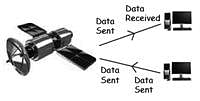Olympiad Test Level 2: Introduction to Internet - 1 - Class 3 MCQ
10 Questions MCQ Test Cyber Olympiad for Class 3 - Olympiad Test Level 2: Introduction to Internet - 1
Nowadays, we can watch live telecasts of music concerts or cricket matches in TV. TV channels use _______ to transmit their programs with the help of computers.
What is Uniform Resource Locator (URL)?
| 1 Crore+ students have signed up on EduRev. Have you? Download the App |
Which of the following statements is/are correct about the given figure?

1. It has an address bar in which URL of the websites is typed.
2. It can be used to open a search engine.

1. It has an address bar in which URL of the websites is typed.
2. It can be used to open a search engine.
A ______ is a program that searches for web documents with specific keywords.
Which of the following is a web search engine?
Which of the following options is used to access the information available on the World Wide Web?
Your brother has scored well in his exam and you want to congratulate him but he lives outside India. Which of the following devices can be used to connect with your brother?
The given image shows the _______ of computer with __________.

Each website on the Internet contains a ________, which gets displayed when you open the site for the first time. The user interface that is used to access a website is called _________.
|
20 videos|42 docs|71 tests
|
|
20 videos|42 docs|71 tests
|

















